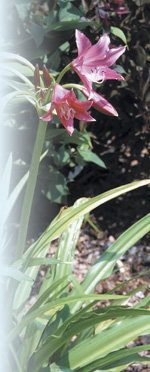Crinums Add Tropical Splendor
go.ncsu.edu/readext?236055
en Español / em Português
El inglés es el idioma de control de esta página. En la medida en que haya algún conflicto entre la traducción al inglés y la traducción, el inglés prevalece.
Al hacer clic en el enlace de traducción se activa un servicio de traducción gratuito para convertir la página al español. Al igual que con cualquier traducción por Internet, la conversión no es sensible al contexto y puede que no traduzca el texto en su significado original. NC State Extension no garantiza la exactitud del texto traducido. Por favor, tenga en cuenta que algunas aplicaciones y/o servicios pueden no funcionar como se espera cuando se traducen.
Português
Inglês é o idioma de controle desta página. Na medida que haja algum conflito entre o texto original em Inglês e a tradução, o Inglês prevalece.
Ao clicar no link de tradução, um serviço gratuito de tradução será ativado para converter a página para o Português. Como em qualquer tradução pela internet, a conversão não é sensivel ao contexto e pode não ocorrer a tradução para o significado orginal. O serviço de Extensão da Carolina do Norte (NC State Extension) não garante a exatidão do texto traduzido. Por favor, observe que algumas funções ou serviços podem não funcionar como esperado após a tradução.
English
English is the controlling language of this page. To the extent there is any conflict between the English text and the translation, English controls.
Clicking on the translation link activates a free translation service to convert the page to Spanish. As with any Internet translation, the conversion is not context-sensitive and may not translate the text to its original meaning. NC State Extension does not guarantee the accuracy of the translated text. Please note that some applications and/or services may not function as expected when translated.
Collapse ▲
‘Ellen Bosanquet’
Photo by Robert E. Lyons
Crinums are great summer-flowering bulbs that have graced Southern landscapes for years. They lend a bit of nostalgia and add a delightful tropical touch to gardens. Their coarse sword-like foliage is lustrous and statuesque, providing a pleasing contrast to finer textured ornamentals.
The flowers of the more common crinums resemble those of the Easter lily. Many choices are available, however, and the flowers range from bell shaped to spiderlike in appearance. Colors range from deep reds, pinks and whites to bicolors. The white form ‘Album’ and the wine-red ‘Rubra’ are choice garden plants.
This member of the amaryllis family is one of the more cold-hardy bulbs, and it can be safely planted in the eastern regions of our mountains. Those living in the far western regions of North Carolina can grow crinums in containers that can be brought inside for the winter.
Plant crinums in April and continuing through late October. They thrive in sunny locations, provided the soil is moist, or in filtered shade. When looking for plants that grow well in woodland shade gardens, consider C. moorei.

C. procerum ‘Splendens’
Photo by Robert E. Lyons
Newly planted crinums need to settle in for a season or two before they begin blooming freely. They do not like to be disturbed. After the first flowering season, apply a high-phosphorus fertilizer in mid-May each year. Provide plenty of water during the bloom period if there is a drought. After 4 to 5 years, remove the offsets and replant to enlarge your collection or to share with a gardening friend.
Many of the crinum cultivars are age-old hybrids. Most are crosses of C. bulbispermumand C. moorei, such as C. x powellii and C. xscabrum. Cultivars include white-flowering ‘Schmidtii’ and ‘White Queen’, pink ‘Cecil Houdyshel’ and ‘Roseum’, red ‘Carnival’ and bicolor ‘Milk and Wine’.
Hardy crinums and their related hybrids are prominent members of the perennial border at the JC Raulston Arboretum. Tender species like the lovely purple leaf form, C. procerum ‘Splendens’, have been planted in containers for their seasonal beauty.
Darrell Blackwelder


